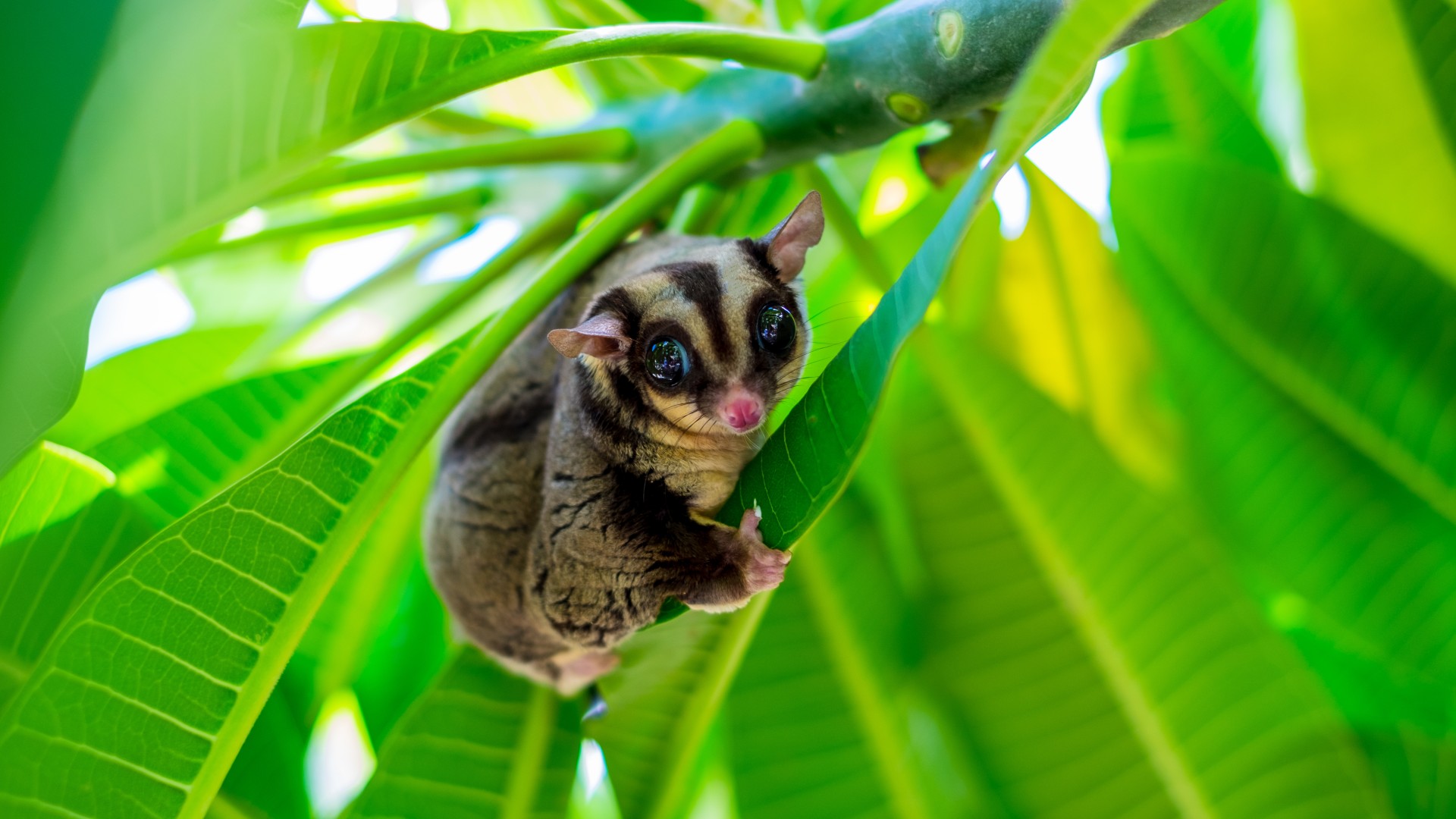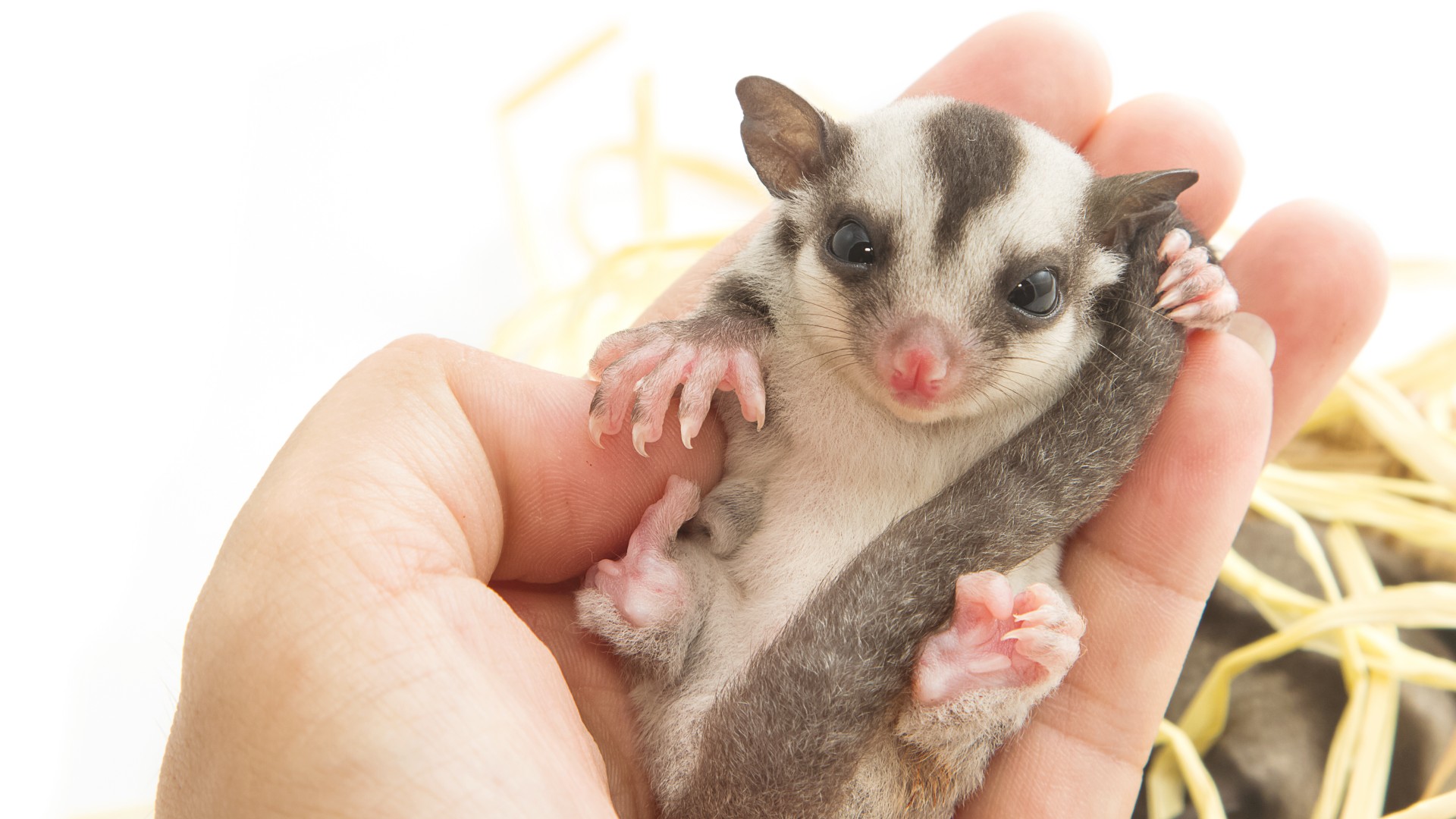Should you keep sugar gliders as pets? Everything you need to know
Keeping sugar gliders as pets is becoming a more popular choice, but these wild marsupials require specialized care you'll want to be aware of before adopting

Whether keeping sugar gliders as pets is a good idea or not remains a hot topic of debate, with some saying they can make wonderful companions who will bond strongly with their human families and others believing that the specialized care they require makes them unsuitable for domestic living.
It’s important to note that sugar gliders are wild animals and while they can make for playful, curious and social pets who will happily engage in a good snuggle session, they require a very particular diet, ample amounts of space, and plenty of mental and physical enrichment to keep them happy and healthy.
Sugar gliders are also highly social creatures who live in small groups in the wild and need to have at least one other buddy to share their enclosure with to ensure they don’t become depressed. Because of this, you’ll need to be financially prepared to adopt and care for a pair.
Not for the novice pet owner, sugar gliders require a substantial time investment, not least because they need regular human interaction in order for them to become tame and used to being handled. However, if you’re able to provide them with this, you’ll likely be rewarded with an endearing and entertaining companion.
Below, we walk you through the pros and cons of owning sugar gliders as pets so that you can make an informed decision about whether these cute little creatures are the right choice for your home and lifestyle.
- What is an axolotl and do they make good pets?
- Serval cats: Can you keep as a pet? History, care and breed information
What is a sugar glider?
While sugar gliders may look like rodents, they’re actually small marsupials that come from the same general family as kangaroos and koala bears. They got the name ‘sugar glider’ because they love eating sweet foods, especially fruit, and because they have a gliding membrane that stretches from their wrist to their ankle that allows them to glide between trees.
Sugar gliders have been found to have around the same level of intelligence as a dog and they can be trained to learn tricks and to come when they’re called. When cared for correctly, sugar gliders have an average lifespan of between 12-15 years. They are impeccably clean, never require bathing and are known to bond strongly to their human family when kept as domestic pets.
Should you keep sugar gliders as pets?
We wish we could give you a straightforward yes or no answer to the question of whether you should keep a sugar glider as a pet, but unfortunately, professional opinion on this one is mixed.
Often referred to as ‘sugar bears’, these pocket pets have become popular amongst those looking for a small, social and sensitive little creature to provide them with companionship.
But animal welfare organizations, such as PETA, say that many sugar gliders end up in shelters because people are unprepared for the responsibility of caring for an active, inquisitive and nocturnal animal.
Because of this, sugar gliders are illegal in several states, including Alaska, Hawaii and California, and in those states that do allow them, you’ll want to check with your local authority as to whether or not you need a permit.
Sugar gliders are highly social animals who require a lot of opportunities to socialize with their kind, plenty of stimulation and enrichment, and a large living space to ensure they don’t become depressed - which they are prone to if their needs are not being met.
If you’re considering a sugar glider as a pet, you’ll want to ensure you can provide the right environment, have plenty of room for a large enclosure, and have the time and money to be a pet parent to two of these adorable little marsupials as they must live with at least one other sugar glider for companionship.
Below, we outline the pros and cons to keeping sugar gliders so you make an informed decision about whether these curious creatures are the right fit for you and your family.
The pros of sugar gliders as pets

When it comes to the pros of having one as a pet, you’ll find that there’s a lot to love about the sugar bear. Here are some of the reasons they can make wonderful companions:
1. They have a long lifespan
Sugar gliders can make fantastic pets for children, as unlike other pocket pets, they can live for up to 15 years when cared for correctly - which makes them on par with most dogs and cats when it comes to longevity.
Because of this, they can be a great way of teaching children about the ongoing responsibilities that come with having a long-term pet.
2. They’re very clean
With impeccable cleaning habits, the sugar glider is a great choice if you’re looking for a pet that you don’t have to bathe or regularly clean up after. Unlike other rodents, sugar gliders don’t require dust baths or the use of wet or dry shampoo and will instead groom themselves and each other daily to keep their coats in tip-top condition.
You’ll also find that sugar gliders do a good job of keeping their cages tidy as they prefer a clean environment, so you’ll only need to do a spot clean every couple of days and a deep clean every two to three three weeks.
3. Sugar gliders rarely bite
Unlike some other pocket pets, sugar gliders are unlikely to bite unless they’re feeling scared or are being mishandled in a way that hurts them. Even on the odd occasion when they do bite, the structure of their teeth means that it feels more like a pinching sensation.
Because sugar gliders bond quite deeply with their humans, as your relationship with your pocket pet deepens, biting will likely only happen if something spooks them while you happen to be holding them.
4. They’re super playful
Curious, intelligent and highly active, sugar gliders are well known for their playful antics and the great news is that they enjoy playing with people as much as they enjoy playing with each other.
With a love of climbing any and all vertical surfaces just so they can glide back down to the floor again, sugar gliders make for wonderfully interactive and engaging pets who will delight in having your full attention.
5. Sugar gliders love a good cuddle
If you want a pet who will snuggle with you, a sugar glider is well worth considering. Known to bond very deeply with their humans, they’re quite content to curl up in a sling against your chest or in the cozy and warm pocket of your jumper or jacket.
For those that work from home or live alone, a sugar glider can make for a great cuddly companion.
The cons of sugar gliders as pets

Now that we’ve explored some of the advantages of owning a sugar glider, it’s time to look at some of the very real disadvantages that you’ll want to seriously consider before adopting two or more of these pocket pets.
1. They’re nocturnal
Sugar gliders are nocturnal, which means they sleep most of the day and are highly active at night. Because of that, you’ll need to keep them in a dark environment and avoid waking them up during daylight hours as this can confuse them and mess with their hormones.
Their sleeping habits mean that it will also be much harder to play with them, unless you happen to be a night owl yourself.
2. Vets find them hard to treat
Most vets aren’t trained in the treatment of exotic animals, which means you likely won’t be able to just pop along to your local vet if your sugar glider happens to get injured or become unwell.
It can be difficult to diagnose and treat a sugar glider without causing them distress or harm and getting the dosage of medication right is also challenging. Make sure you have a specialized vet in your area who can handle the requirements of your sugar bear.
3. Many sugar gliders are farmed and bred in cruel environments
Similar to puppy mills, sugar gliders are also often bred in unhealthy environments in order to meet the increase in demand amongst pet parents. With little control over breeding practices, sugar gliders are often overbred and inbred and can suffer severe health problems as a result, including behavioral issues, shortened lifespans, dwarfism, mental instability and genetic disorders.
If you’ve decided to get a sugar glider, be sure to get one from a licensed, professional breeder or animal shelter.
4. They’re expensive to purchase and care for
It’s not unusual for a pair of sugar gliders to cost anywhere from $500 to $1300 and that’s before you buy their cage, food and toys. Because they’re an exotic animal, the cost of vet treatment is also significantly higher than your standard domestic pet, so you’ll want to make sure you have the finances to care for your sugar gliders before you take them on. And remember, they can live for up to 15 years.
5. Their diet can be difficult to get right
Unlike a dog or cat, sugar gliders have a fairly complex diet that must consist of the following:
- Fruits and vegetables with a 2:1 calcium to phosphorus ratio
- Insects
- A multivitamin
- A protein source
- A nectar drink
- Acacia gum
- Bee pollen
Sugar gliders are fragile and require their diet to be consistently on point to ensure they don’t become sick. Vets report that the most common health issues they see when caring for sugar gliders are diet related with malnutrition, weight problems, deficiencies and poisonings all common.
If you decide to adopt a pair of sugar gliders, you’ll want to make sure that you thoroughly research what to feed them, how often and the correct amounts to ensure they stay physically fit.
PetsRadar Newsletter
Get the best advice, tips and top tech for your beloved Pets

Kathryn is a freelance writer who has been a member of the PetsRadar family since it launched in 2020. Highly experienced in her field, she's driven by a desire to provide pet parents with accurate, timely, and informative content that enables them to provide their fur friends with everything they need to thrive. Kathryn works closely with vets and trainers to ensure all articles offer the most up-to-date information across a range of pet-related fields, from insights into health and behavior issues to tips on products and training. When she’s not busy crafting the perfect sentence for her features, buying guides and news pieces, she can be found hanging out with her family (which includes one super sassy cat), drinking copious amounts of Jasmine tea and reading all the books.
